| Polyporus ciliatus | |
|---|---|
 | |
| Scientific classification | |
| Kingdom: | |
| Phylum: | |
| Class: | |
| Order: | |
| Family: | |
| Genus: | |
| Species: | P. ciliatus |
| Binomial name | |
| Polyporus ciliatus Fries 1815 | |
Polyporus ciliatus is a species of fungus in the genus Polyporus. [1]
| Polyporus ciliatus | |
|---|---|
 | |
| Scientific classification | |
| Kingdom: | |
| Phylum: | |
| Class: | |
| Order: | |
| Family: | |
| Genus: | |
| Species: | P. ciliatus |
| Binomial name | |
| Polyporus ciliatus Fries 1815 | |
Polyporus ciliatus is a species of fungus in the genus Polyporus. [1]
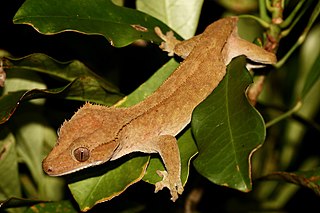
The crested gecko or eyelash gecko is a species of gecko native to southern New Caledonia (France). In 1866, the crested gecko was described by French zoologist Alphonse Guichenot. This species was thought to be extinct until it was rediscovered in 1994 during an expedition led by Robert Seipp. Along with several other New Caledonian gecko species, it is being considered for protected status by the Convention on the International Trade in Endangered Species of Wild Flora and Fauna.

Cerioporus squamosus aka Polyporus squamosus is a basidiomycete bracket fungus, with common names including dryad's saddle and pheasant's back mushroom. It has a widespread distribution, being found in North America, Australia, Asia, and Europe, where it causes a white rot in the heartwood of living and dead hardwood trees. The name "dryad's saddle" refers to creatures in Greek mythology called dryads who could conceivably sit and rest on this mushroom, whereas the pheasant's back analogy derives from the pattern of colors on the bracket matching that of a pheasant's back.

Bromus is a large genus of grasses, classified in its own tribe Bromeae. They are commonly known as bromes, brome grasses, cheat grasses or chess grasses. Estimates in the scientific literature of the number of species have ranged from 100 to 400, but plant taxonomists currently recognize around 160–170 species.

Polyporus is a genus of poroid fungi in the family Polyporaceae.

Bromus ciliatus is a species of brome grass known by the common name fringed brome. It is native to most of North America, including most of Canada, most of the United States except for some portions of the South, and northern Mexico. It is a plant of many habitats, including temperate coniferous forest. The specific epithet ciliatus is Latin for "ciliate", referring to the delicate hairs of the leaf blades.
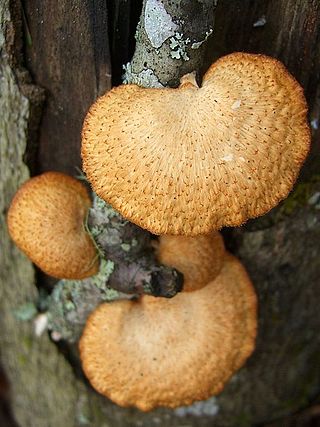
Neofavolus alveolaris, commonly known as the hexagonal-pored polypore, is a species of fungus in the family Polyporaceae. It causes a white rot of dead hardwoods. Found on sticks and decaying logs, its distinguishing features are its yellowish to orange scaly cap, and the hexagonal or diamond-shaped pores. It is widely distributed in North America, and also found in Asia, Australia, and Europe.
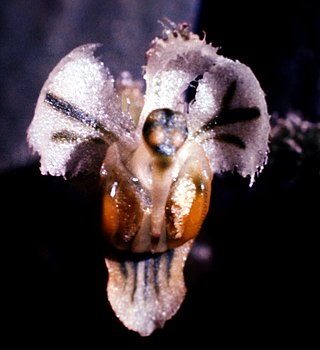
Ornithocephalus ciliatus is a species of orchid found from Trinidad, the Guianas, Venezuela, Ecuador, Peru and Brazil.

Leptosiphon ciliatus is a species of flowering plant in the phlox family known by the common name whiskerbrush.
Polyporus phyllostachydis is a fungus species belonging to the genus Polyporus. It is a species known from Japan to grow on the ground on the living or dead roots of the Phyllostachys edulis bamboo.

Polyporus umbellatus is an edible species of mushroom, found growing on roots of old beeches or oak (e.g.). It is also called umbrella polypore.
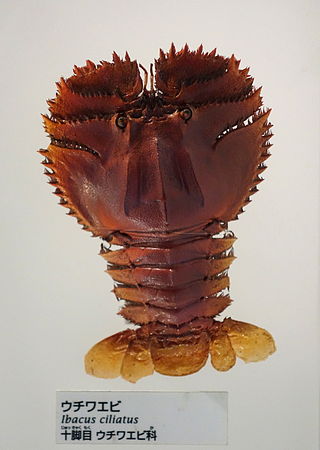
Ibacus ciliatus is a species of slipper lobster from the north-west Pacific Ocean.

Picipes badius, commonly known as the black-footed polypore or black-leg, is a species of fungus in the family Polyporaceae. It causes a white rot of hardwoods and conifers. The species is found in temperate areas of Asia, Australia, Europe, and North America. It has a dark brown or reddish-brown cap that reaches a diameter of 25 cm (9.8 in), and a stipe that is often completely black or brown at the top and black at the base.
The Sundaic mountain leopoldamys is a species of rodent from the family Muridae. It was formerly considered a subspecies of Edwards's long-tailed giant rat, and it has one synonym: Leopoldamys setiger.

Lentinus arcularius, also known as the spring polypore, is a species of fungus in the family Polyporaceae. It has been found on all continents, but has primarily been documented in the United States, Austria, Mexico, Australia, and Japan. It was first documented in 1783 by German naturalist August Batsch under the name Boletus arcularius. It was later renamed to Polyporus arcularius in 1821 by Swedish mycologist Elias Magnus Fries before being recently (2010) transferred to the genus Lentinus.

Polyporus gayanus is a species of fungus in the genus Polyporus. It was first documented in 1846 by French mycologist Joseph-Henri Léveillé.

Polyporus tuberaster, commonly known as the tuberous polypore or stone fungus, is a species of fungus in the genus Polyporus. It is easily identified by the fact that it grows from a large sclerotium that can resemble buried wood or a potato.

Dineutus ciliatus is a species of whirligig beetle in the family Gyrinidae. It is found in North America.
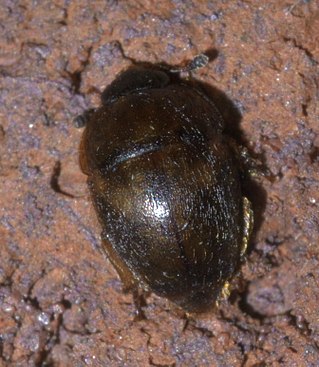
Amphicrossus ciliatus is a species of sap-feeding beetle in the family Nitidulidae. It is found in the Caribbean Sea, Central America, and North America.

Sebastes ciliatus, the dusky rockfish, is a species of marine ray-finned fish belonging to the subfamily Sebastinae, the rockfishes, part of the family Scorpaenidae. It is typically found in the North Pacific Ocean, specifically in the Bering Sea near British Columbia, in the Gulf of Alaska, and in the depths of the Aleutian Islands.